Photons & Fusion Newsletter
May 2012
Reducing the Time to Grow Good Cryogenic Layers
One of the most demanding aspects of preparing targets for NIF ignition experiments is growing the wafer-thin layer of solid deuterium-tritium (DT) fuel in the target capsule. Only 69 microns wide – about two-thirds the average width of a human hair – and frozen to 18.5 kelvins (minus-426 degrees Fahrenheit), the "DT ice" layer must be extremely smooth and free of grooves or other defects before the target can be approved for use in an experiment.
Cryogenically cooling the fuel to just below the freezing point of hydrogen, which changes hydrogen's phase from a gas to a liquid and finally to a solid, enhances the density of the fuel and improves the chances of achieving the required density for ignition. The ice layer takes an average of 14 hours of "script time" to grow, so rejection of a completed layer means at least a half-day delay in the experiment while a new layer is grown.
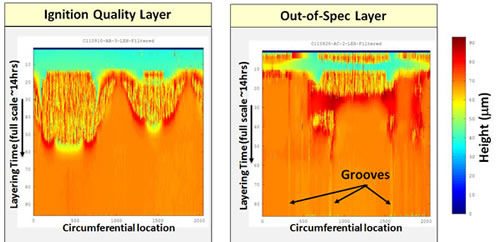 Space-time plots of a growing ignition-quality cryogenic DT layer and an out-of-spec, or "bad" layer. Time runs from top to bottom. X-ray images can be obtained from three different views of the layer. The use of a series of metrics to evaluate DT layers is expected to cut average layering time nearly in half.
Space-time plots of a growing ignition-quality cryogenic DT layer and an out-of-spec, or "bad" layer. Time runs from top to bottom. X-ray images can be obtained from three different views of the layer. The use of a series of metrics to evaluate DT layers is expected to cut average layering time nearly in half. A large effort is under way by NIF target fabrication and cryogenic fielding teams to achieve a higher NIF shot rate through improved engineering, automation, training, and early detection of defective layers. Among the techniques being employed by NIF researchers to shorten the time between experiments is the use of x-ray images called "space-time plots" to evaluate the quality of a layer as it grows. The technique, developed by members of the Target Systems and Optics Technology (TSOT) Group, is "a kind of forensics," said Science & Technology Group Leader Tayyab Suratwala.
"The space-time plots make it easier to visualize the signature of the growing layer and decide early on whether it will be a good layer based on a series of metrics, such as early groove detection and the rate of meniscus (DT layer) height change during early freeze," he said. "The time to yield a good layer can be shortened by detecting a bad layer earlier rather than later. Since February, the space-time plots have been employed as dashboards, allowing for real-time decision-making and increased efficiency."
 Physicist Mike Feit and chemical engineer Rebecca Dylla-Spears of TSOT's Science and Technology Group examine space-time plots of ignition-quality DT layers.
Physicist Mike Feit and chemical engineer Rebecca Dylla-Spears of TSOT's Science and Technology Group examine space-time plots of ignition-quality DT layers. NIF Diagnostics Highlighted at Plasma Diagnostics Conference
A number of LLNL and National Ignition Campaign (NIC) researchers gave presentations at the 19th High Temperature Plasma Diagnostics Conference held May 7-10. The conference was co-sponsored by LLNL and General Atomics (GA) and was chaired by LLNL's Bob Kauffman and GA's Joe Kilkenny.
The biennial conference brings together plasma physicists from a variety of fields, including magnetic confinement fusion, inertial confinement fusion (ICF), space plasmas, astrophysics, and industrial applications, to discuss mutual problems in the development of instrumentation and techniques for the characterization of high-temperature plasmas.
 Attendees watch a presentation at the High Temperature Plasma Diagnostics Conference.
Attendees watch a presentation at the High Temperature Plasma Diagnostics Conference. Science on NIF Technical Review Committee Meets
The Science on NIF Technical Review Committee met at the Laboratory on May 25. The Committee, chaired by University of Chicago Prof. Robert Rosner, former director of Argonne National Laboratory, reviewed progress and plans for fundamental science on NIF.
After welcoming remarks by Ed Moses, the Committee was briefed by NIF User Office Director Chris Keane, interim NIF User Group Chair Professor Justin Wark of the University of Oxford, and researchers playing a leading role in NIF fundamental science experiments, including Lee Bernstein (Physics and Life Sciences), Professor Tom Duffy (Princeton University), Andrea Kritcher (NIF & Photon Sciences), Carolyn Kuranz (University of Michigan), Alex Casner (CEA, France), and John Seely (Naval Research Laboratory). These talks summarized a broad range of ongoing national and international collaborations focused on science on NIF.
The Committee was enthusiastic about progress to date and looks forward to results from fundamental science experiments at NIF planned for later this year and next.
NIF Precision Shock Timing Experiments Described
Recent progress toward achieving ignition conditions on NIF was described in two Physical Review Letters papers published on May 24. In a paper titled, "Precision Shock Tuning on the National Ignition Facility" (DOI:10.1103/PhysRevLett.108.215004), Harry Robey and colleagues discussed results from the first series of precision tuning "keyhole" experiments on NIF, which used optical diagnostics to directly measure the strength and timing of four shocks inside the hohlraum-driven, cryogenic liquid deuterium-filled capsule interior.
In a series of five shots, the strength and timing of these shocks was systematically adjusted, demonstrating a significant decrease in fuel adiabat (internal energy) over previously un-tuned implosions. The impact of the improved shock timing was confirmed in related DT layered capsule implosions, which are described in the second paper below.
Joining Robey on the paper were collaborators from LLNL, Los Alamos National Laboratory (LANL), the Laboratory for Laser Energetics (LLE) at the University of Rochester, General Atomics (GA) in San Diego, and the Massachusetts Institute of Technology (MIT).
from LLNL, Los Alamos National Laboratory (LANL), the Laboratory for Laser Energetics (LLE) at the University of Rochester, General Atomics (GA) in San Diego, and the Massachusetts Institute of Technology (MIT).
In the second paper, "Assembly of High-Areal-Density Deuterium-Tritium Fuel from Indirectly Driven Cryogenic Implosions" (DOI:10.1103/PhysRevLett.108.215005), Andrew Mackinnon and colleagues described a series of NIF experiments that investigated the implosion conditions created using this shock-tuned laser pulse.
The compressibility of the imploded assembly was inferred from measurements of the ratio of down-scattered neutrons to primary neutrons. This down-scattered ratio (DSR) is proportional to the aerial density (ρR) of the fuel surrounding the neutron-producing plasma. These implosions showed the highest fuel compression (ρR about 1.0 g/cm2) measured to date (about two-thirds of the ignition requirement), exceeding the previous record by more than a factor of three.
Joining Mackinnon were collaborators from LLNL, LLE, LANL, Sandia National Laboratories, GA, MIT, the Atomic Weapons Establishment in Aldermaston, UK, and the University of New Mexico.
Laser System for Space Debris Cleaning
The value of U.S. space satellite assets is estimated to be more than $1 trillion, and the worldwide value is nearly twice that. Accumulation of space debris has accelerated, increasing the debris in orbit and posing a major threat to space assets. NASA estimates that there are nearly 100,000 threatening-to-catastrophic-event objects.
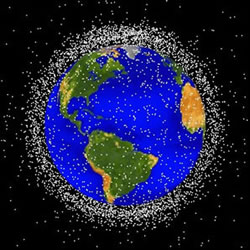 Approximately 95 percent of the tracked objects in low Earth orbit are space debris.
Approximately 95 percent of the tracked objects in low Earth orbit are space debris. LLNL researchers Sasha Rubenchik, Al Erlandson and Duane Liedahl have assessed the laser pulse energy and the number of pulses required for removing orbital debris. In a presentation at the High-Power Laser Ablation Conference (HPLA 2012) on May 2, they said calculations show that a ground-based, diode-pumped, gas-cooled multi-slab laser that uses only modest extensions of existing technology, when used with a three-meter-diameter beam director, would be capable of removing most small debris from low-Earth orbit. Such a laser would also be capable of moving large debris into orbits that avoid high-value satellites and of removing large debris from orbit by illuminating the debris over several encounters.
To date, only systems developed for inertial confinement fusion are close to meeting the requirement for beam directors of reasonable size. The laser design proposed uses diode-pumped, neodymium:glass, gas-cooled amplifiers with 25-centimeter-square apertures.
Also at HPLA 2012, NIF & Photon Science Chief Technology Officer Chris Barty presented a keynote address titled, "Megajoule Lasers and the Pursuit of Fusion at the National Ignition Facility," and LLNL's Sergei Nikolaev gave a talk on "Brute-Force Model for Evolution of Orbital Environment."
LLNL Researchers Give Talks at CLEO: 2012
NIF&PS Director for Laser Fusion Energy Mike Dunne gave an invited presentation at the 2012 Conference on Lasers and Electro-Optics (CLEO: 2012) held May 6-11. Dunne's talk, "Recent Data from the National Ignition Facility," presented the latest results of the National Ignition Campaign and current designs for Laser Inertial Fusion Energy (LIFE) based on experience with NIF.
Also presenting was Andy Bayramian, who gave a talk titled, "A Compact Line Replaceable Unit Laser Driver for Laser Inertial Fusion Energy," and David Alessi, whose talk described the temporal contrast and performance of oscillators to determine their feasibility for future ultra-high-contrast experiments on NIF's Advanced Radiographic Capability.
NIF Director Ed Moses was formally named a Fellow of the Optical Society of America during the conference. Moses was recognized for "outstanding technical leadership of the construction, completion and use of the world's largest and most energetic laser system, the National Ignition Facility."
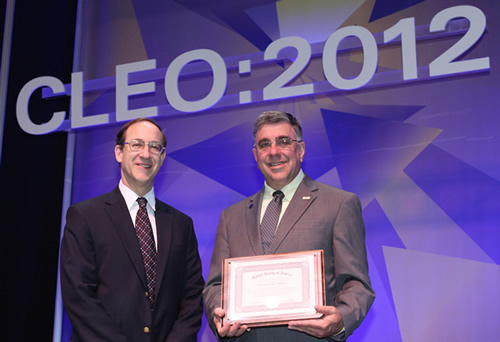 OSA President Tony Heinz of Columbia University (left) presents NIF Director Ed Moses with a certificate designating him an Optical Society of America Fellow.
OSA President Tony Heinz of Columbia University (left) presents NIF Director Ed Moses with a certificate designating him an Optical Society of America Fellow. Workshop Continues Planning for Next Phase of NIF Diagnostics
The seventh in a series of workshops to discuss present and future diagnostic equipment for NIF was held at the Laboratory from May 14 to 16. About 80 members of the National Ignition Campaign and Stockpile Stewardship teams and the fundamental science user communities discussed the development of new diagnostics and plans for converting existing equipment from other high energy density facilities for use on NIF, with its higher energies and radiation levels and larger target chamber. Hosted by Joe Kilkenny, the workshop discussed NIF's future diagnostic requirements and the state of readiness of proposed diagnostic technology to meet those requirements.
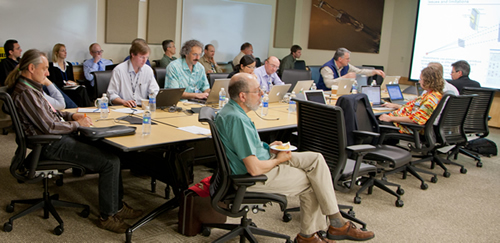 Diagnostics Workshop attendees listen to a presentation.
Diagnostics Workshop attendees listen to a presentation. Measuring Hohlraum-produced Fast Ions
In inertial confinement fusion (ICF) ignition experiments, "hot" (high-energy) electrons produced by laser-plasma interactions are energetic enough to penetrate the ablator material in the target capsule and deposit energy in the cryogenic fuel, which increases the fuel adiabat (internal energy) and thus reduces fuel compressibility. Understanding hot electron production and preheat is therefore critical for achieving ignition.

The first measurements of fast ions produced in indirect-drive hohlraum experiments and their relationship to hot electrons were described by MIT and LLNL researchers in a Physics of Plasmas article published online April 30 (http://dx.doi.org/10.1063/1.4707410). In experiments at the OMEGA laser facility at the University of Rochester, the researchers observed protons in two energy regimes associated with different fast-ion production mechanisms. In both cases, runaway electrons set up a strong electrostatic field that accelerates the measured ions. Fast protons with energies from 300,000 to 800,000 electron volts were observed in both vacuum and gas-filled hohlraums.
Lead author Alex Zylstra, a Ph.D. student in MIT’s Plasma Science and Fusion Center, was joined on the paper by fellow Ph.D. students Mike Rosenberg and Hans Rinderknecht, MIT/NIF Ph.D. thesis advisor Richard Petrasso and other MIT colleagues, and LLNL's Nobuhiko Izumi, Peter Amendt, Nino Landen, and Jeff Koch. The students are the first to participate in a new NIF Ph.D. thesis program.
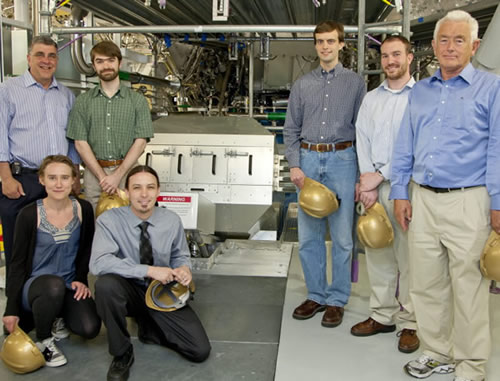 NIF Director Ed Moses (left) and Joe Kilkenny of General Atomics (right) with (from left) MIT postdoc Maria Gatu-Johnson, MIT Ph.D. student Hans Rinderknecht, recent MIT Ph.D. Dan Casey, and MIT Ph.D. students Alex Zylstra and Mike Rosenberg. Casey's recently defended thesis, "Diagnosing Inertial Confinement Fusion Implosions at OMEGA and the NIF Using Novel Neutron Spectrometry," is the first NIF-based Ph.D. thesis. Rinderknecht, Rosenberg and Zylstra are also working on different NIF nuclear diagnostics and analyses. MIT's Plasma Science & Fusion Center is playing a key role in developing, testing and calibrating diagnostic equipment for NIF.
NIF Director Ed Moses (left) and Joe Kilkenny of General Atomics (right) with (from left) MIT postdoc Maria Gatu-Johnson, MIT Ph.D. student Hans Rinderknecht, recent MIT Ph.D. Dan Casey, and MIT Ph.D. students Alex Zylstra and Mike Rosenberg. Casey's recently defended thesis, "Diagnosing Inertial Confinement Fusion Implosions at OMEGA and the NIF Using Novel Neutron Spectrometry," is the first NIF-based Ph.D. thesis. Rinderknecht, Rosenberg and Zylstra are also working on different NIF nuclear diagnostics and analyses. MIT's Plasma Science & Fusion Center is playing a key role in developing, testing and calibrating diagnostic equipment for NIF. Laser Damage Precursors on Fused Silica Surfaces
Surface laser damage limits the lifetime of optics for systems guiding high-fluence pulses, particularly damage in silica optics used for ICF-class lasers such as NIF. The density of damage precursors at low fluence (energy per unit area)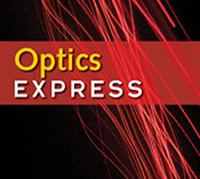 has been measured using large beams (1-3 centimeters); higher fluences cannot be measured easily, however, since the high density of resulting damage initiation sites results in clustering.
has been measured using large beams (1-3 centimeters); higher fluences cannot be measured easily, however, since the high density of resulting damage initiation sites results in clustering.
In an Optics Express article published on May 4 (http://dx.doi.org/10.1364/OE.20.011561), LLNL researchers report on the development of an automated damage testing station and analysis that make it possible to damage-test thousands of sites with small beams (10-30 microns) and automatically image the test sites to determine if laser damage occurred. For both uncoated and coated fused silica samples, the distribution of precursors nearly flattens at very high fluences, up to 150 joules/cm2, providing important constraints on the physical distribution and the nature of these precursors. This experimental procedure and analysis can be applied to a wide variety of optical materials to determine their damage behavior over wide fluence ranges.
Joining lead author Ted Laurence on the paper were Jeff Bude, Sonny Ly, Nan Shen, and Michael Feit.
Workshop on the Science of Fusion Ignition on NIF
An international workshop on the science of ignition on NIF was held from May 22-24 in San Ramon, CA. The workshop was designed to discuss the science of ignition and the implications of the science that has been learned in the National Ignition Campaign (NIC). The workshop was also intended to develop, engage, and expand the community of scientists interested in exploring the science of ignition on NIF.
Following welcoming remarks by LLNL Director Parney Albright, the National Nuclear Security Administration's ICF Director, Jeff Quintenz, and NIF Director Ed Moses, LLNL Associate Director for Physical and Life Sciences Bill Goldstein described the workshop's goals and deliverables. NIF Chief Scientist John Lindl presented an overview and status report on the ignition effort and Diagnostics Leader Joe Kilkenny discussed ignition measurements.
The group then held panel discussions and presented outbriefs on six areas: laser propagation and x-ray generation, x-ray transport and ablation physics, implosion hydrodynamics, stagnation properties and burn, high energy density materials, and integrated modeling.
International Particle Accelerator Conference
LLNL researchers gave several presentations at the International Particle Accelerator Conference (IPAC 2012) held May 20-25. An invited talk by Roark Marsh, "Ultracompact Accelerator Technology for a Next-Generation X-ray Source," described the technology choices and progress in manufacturing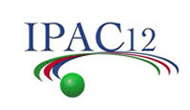 and testing the injector and accelerator of a 250-MeV ultra-compact Compton scattering X-ray source under development at LLNL. In separate talks, Marsh discussed the X-band test station being developed at the Laboratory to investigate accelerator optimization for future upgrades to LLNL's mono-energetic gamma-ray (MEGa-Ray) technology; precision magnet measurements for X-band accelerator quadrapole triplets; and the challenges involved in modeling a multi-bunch X-band photoinjector.
and testing the injector and accelerator of a 250-MeV ultra-compact Compton scattering X-ray source under development at LLNL. In separate talks, Marsh discussed the X-band test station being developed at the Laboratory to investigate accelerator optimization for future upgrades to LLNL's mono-energetic gamma-ray (MEGa-Ray) technology; precision magnet measurements for X-band accelerator quadrapole triplets; and the challenges involved in modeling a multi-bunch X-band photoinjector.
Also presenting at IPAC 2012 were David Gibson, who described a drive laser for multi-bunch photoinjector operation and the narrow-band optimization of a Compton scattering gamma-ray source produced from an X-band linac; and Scott Anderson, who described the high-gradient inverse free electron laser accelerator being developed by LLNL and UCLA.
20th Target Fabrication Conference
A number of LLNL researchers participated in the 20th Target Fabrication Conference held May 20-24. Featured were presentations by Steve Haan and colleagues from LLNL and Los Alamos National Laboratory on the current status of NIF ignition campaign target performance and requirements, and by Beth Dzenitis and colleagues from LLNL and General Atomics on cryogenic target production for commissioning tuning techniques and the first ignition tuning campaign on NIF. Both presentations discussed the design, purpose, and results of the various target designs used on NIF.
Additional LLNL talks covered cryogenic targets, hohlraum fabrication, and advanced ablator capsules for NIF as well as target assembly, metrology, and cleaning.
Susana Reyes Named Vice-Chair of ANS Fusion Energy Division
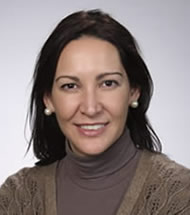 Susana Reyes
Susana ReyesLLNL nuclear engineer Susana Reyes, leader of Laser Inertial Fusion Energy (LIFE) Licensing and Tritium Systems, has been elected vice-chair of the American Nuclear Society (ANS) Fusion Energy Division and will serve as Chair in 2013.
Susana has more than 12 years of experience in international fusion projects. She earned a M.Sc. in Power Engineering from the Polytechnic University of Madrid in 1998 and a Ph.D. in Nuclear Engineering from the UNED University in Madrid in 2001. She then joined LLNL's Fusion Energy Program to work on the safety analysis of inertial fusion energy power plant designs.
Since then, she has worked in a variety of fusion research projects, such as the ITER magnetic fusion facility under construction in Cadarache, France, where she was in charge of coordinating safety analyses in preparation for ITER licensing. She has also been strongly involved in neutronics and materials damage simulations at LLNL in support of high-energy accelerators and NIF.
Lynn Seppala Named Senior Member of Optical Society
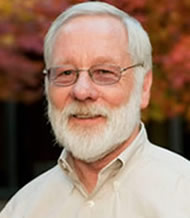 Lynn Seppala
Lynn SeppalaVeteran LLNL optical engineer and designer Lynn G. Seppala has been named a senior member of the Optical Society of America (OSA), an international society for optics and photonics scientists, engineers, educators, and business leaders. Senior membership status recognizes members with more than 10 years of significant experience and professional accomplishments or service in their field. Seppala received this recognition for his contributions to optics research.
Seppala joined LLNL in 1976 and now serves as chief optical designer for the laser fusion program. He received his Ph.D. in optics from the University of Rochester in 1974, was selected as the 2011 Distinguished Alumnus for the Hajim School of Engineering and Applied Sciences, and was inducted into the South Dakota Hall of Fame last September. In addition to his work on NIF, he was a key contributor to the optical design of the 8.4-meter-diameter Large Synoptic Survey Telescope.
Reps. Waxman and Lofgren Visit NIF
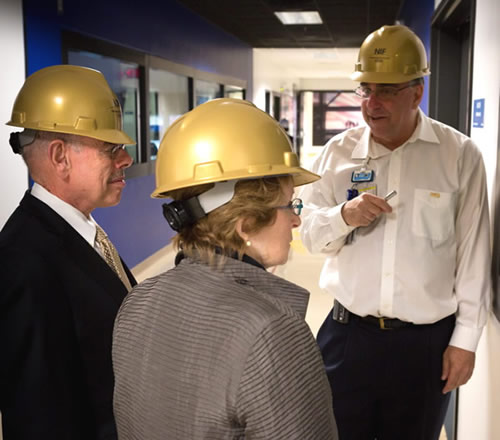 NIF Director Ed Moses (right) briefs California Rep. Henry Waxman, ranking member of the U.S. House Energy and Commerce Committee, and his wife Janet during their tour of NIF on May 25. California Rep. Zoe Lofgren, a member of the House Committee on Science, Space, and Technology, also visited NIF on May 25 along with members of her staff.
NIF Director Ed Moses (right) briefs California Rep. Henry Waxman, ranking member of the U.S. House Energy and Commerce Committee, and his wife Janet during their tour of NIF on May 25. California Rep. Zoe Lofgren, a member of the House Committee on Science, Space, and Technology, also visited NIF on May 25 along with members of her staff. 


